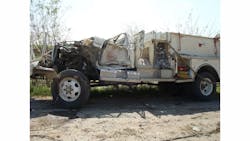NIOSH: West Firefighters Had No Plan for Fertilizer Plant Response
Failure to recognize the hazards of ammonium nitrate and the lack of pre-planning were among factors that contributed to the deaths of 10 responders at the West fertilizer plant in 2013, NIOSH officials have determined.
Read the entire report on West
Among the key recommendations are that ammonium nitrate should be stored in purpose-built facilities of non-combustible construction. And, fire service personnel and other emergency responders should visit facilities that report the presence of ammonium nitrate, and note the conditions of storage and handling.
"Fire departments should have a written risk management plan" they wrote in the document.
Contributing factors included:
• Fire quickly spread to an un-controllable size
• Approximately 40-60 tons of solid ammonium nitrate unexpectedly detonated
• Responders working within blast radius at time of explosion
• Large non-sprinklered, wood construction, commercial structure.
Killed in the blast that registered 2.1 on the Richter scale were West firefighters Morris Bridges, 41; Cody Dragoo, 50; Joseph Pustejousky; Douglas Snokhous , 50; and Robert Snokhous, 48.
Others killed were Dallas Fire-Rescue Kenny Harris, Abbott FD/West EMS -- Cyrus Reed and Jerry Chapman; Merknel FD/West EMS Perry Calvin and Bruceville Eddy FD/EMS Kevin Sanders.
The 50-page report made 13 recommendations, from training requirements and mutual aid policies to alcohol use and prevention and code ideas.
NIOSH investigators also scrutinized the training of firefighters.
"The State of Texas does not have any minimum training requirements for volunteer fire departments. It is up to each fire chief at each department to set their own training requirements. The fire department involved in this incident did not have specific training requirements for fire fighter, fire officer or incident commander duties. The fire department’s normal procedure was for one of the captains to assume incident command."
Many fire fighters may be called upon to fill company officer and incident commander roles when they may not have received adequate training to prepare them for the additional responsibilities that are required of fireground officers. At a minimum, fire fighters who serve as company officers and who may be expected to serve as the initial incident commander should receive training equivalent to Fire Fighter II, as defined by NFPA 1001."
